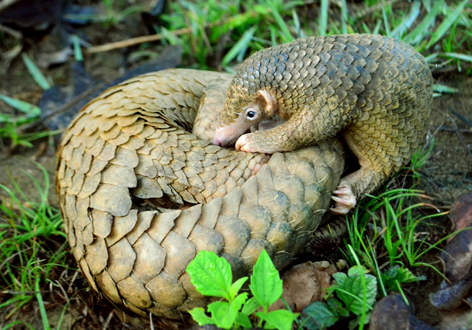If you had asked me two months ago what a pangolin is, I would have guessed that it’s a musical instrument. But, due to #COVID19, this animal may end up impacting your life more this year than any other (except for maybe your pet keeping you company in quarantine). A thread.
You might wonder how viruses can persist for so long when their goal seems to be to destroy the host that they infect. This is possible because many viruses have what is called a reservoir. When you hear “reservoir” you may think of a lake or retention pond that holds water.
It is much the same when it comes to viruses. In the case of coronaviruses, bats serve as the reservoir, as they are able to be infected with the virus and carry a large viral load, but without showing symptoms of illness.
So, what do the pangolins have to do with this? The pangolins matter because it’s all about how the virus gets from the bat reservoir to humans. Some viruses can be directly transferred from bats to humans, but this doesn’t seem to be the case with COVID-19.
The reason why has to do with the way that the virus infects cells. The outer shell of the virus is made up of several different proteins, and the one that is most important for infection is the spike protein. It’s the pointy red one in the picture below.
For COVID-19, the spike protein interacts with a protein on your cells called ACE2. Bats also have an ACE2 protein, but it is very different from ours. So, scientists have hypothesized that the virus was transferred from bats to some other animal and then to humans.
If you& #39;re curious, this process is called “zoonotic transfer” or “zoonosis” – that just means moving between humans and other animals, but now you can impress your friends with your awesome vocabulary at your next (virtual) party.
As the COVID-19 outbreak began to intensify, scientists started to look for the missing link between bats and humans, and evidence is mounting that it is the pangolin, an endangered species which is smuggled and sold on the black market.
How do researchers know that the pangolin is the intermediate? We may never know for sure, but there are two forms of evidence. One is the overall similarity in the RNA sequences between pangolin and human COVID-19.
Researchers recovered the virus that was infecting pangolins and showed that the similarity is about 90% for the RNA sequence that encodes the instructions for how to make the virus. That isn’t particularly high, and so there is still some doubt. https://www.nature.com/articles/s41586-020-2169-0">https://www.nature.com/articles/...
However, more convincing evidence comes from looking at the spike sequence. Humans and pangolins have much more similar ACE2 proteins on our cells, and the part of the viral spike protein that interacts with ACE2 is also very similar between humans and pangolins.
In fact, researchers found that of the 5 key amino acid building blocks that guide the spike protein to interact with ACE2, 4 of the 5 are the same for the pangolin and human viruses, but are very different from the ones in the bat virus. https://www.sciencedirect.com/science/article/pii/S0960982220303602">https://www.sciencedirect.com/science/a...
Before you get upset at the pangolins, they are just innocent bystanders in all of this. It is due to human activity that they are taken from their habitats and brought to places that they can infect several people with the viruses they carry.
It will be some time before we know for sure which animal served as the intermediate in the COVID-19 outbreak, but after the next year, we will probably all know much more about pangolins than we ever thought possible.

 Read on Twitter
Read on Twitter



